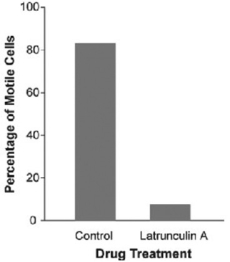Use the following information to answer the question.
The mechanism of cell crawling in protist species is not well defined. Pseudopodia extension involves interactions between actin and myosin (the same molecules that are involved in vertebrate muscle contraction) . However, prior to the study described below, no one had provided convincing data that actin and myosin were actually involved in cell crawling in protists. Anatomical studies had identified the cytoskeletal protein actin just below the surface of the cell membrane in several species of protist, but physiological studies had failed to show a functional link between actin, myosin, and cell crawling.
In a study by N. Poulsen et al. (Diatom gliding is the result of an actin-myosin motility system, Cell Motility and the Cytoskeleton 44 (1999) :23-22) , researchers tested whether motility in a particular species of diatom involves interactions between actin and myosin.
Refer to the study by Poulsen et al. and the figure above. Latrunculin A is a reversible toxin that disrupts the formation of actin fibers. A culture of a particular species of diatom was treated with this toxin diluted in a buffer, while another culture was treated only with the buffer (no toxin; control) . The motility of cells in each culture was assessed by counting the number of cells that were moving during a defined period of time. Which of the following conclusions is reasonable based on the above figure?
Definitions:
Q5: Liverworts, hornworts, and mosses are grouped together
Q22: The evolution of similar insulating skin coverings
Q23: What is metagenomics?<br>A) genomics as applied to
Q31: In the formula for determining a population's
Q40: You sample a population of butterflies and
Q44: The following question is based on the
Q56: Use the table to answer the
Q57: Whatever its ultimate cause(s), the Cambrian explosion
Q64: In what respect do hominins differ from
Q76: Biologists think that endosymbiosis gave rise to